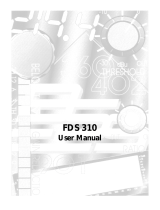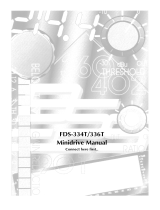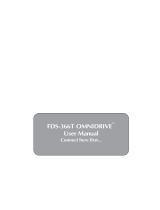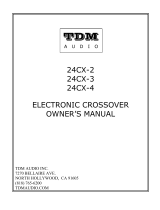Page is loading ...

1
FDS-318
User Manual

2
This equipment has been tested and found to comply with the following European and
international Standards for Electromagnetic Compatibility and Electrical Safety:
Radiated Emissions (EU): EN55013 (1990) Associated Equipment
RF Immunity (EU): EN50082/1 (1992) RF Immunity, Fast Transients ESD
Mains Disturbance (EU): EN61000/3/2 (1995)
Electrical Safety (EU): EN60065 (1993)
Radiated Emissions (USA): FCC part 15 Class B
Electrical Safety (USA): UL813/ETL (1996) Commercial Audio Equipment
Electrical Safety (CAN): UL813/ETLc (1996) Commercial Audio Equipment
IMPORTANT SAFETY INFORMATION
DO NOT REMOVE COVERS. NO USER SERVICEABLE PARTS INSIDE, REFER SERVICING TO QUALIFIED
SERVICE PERSONNEL. THIS EQUIPMENT MUST BE EARTHED.
IT SHOULD NOT BE NECESSARY TO REMOVE ANY PROTECTIVE EARTH OR SIGNAL CABLE SHIELD
CONNECTIONS TO PREVENT GROUND LOOPS. ANY SUCH DISCONNECTIONS ARE OUTSIDE THE
RECOMMENDED PRACTICE OF BSS AUDIO AND WILL RENDER ANY EMC OR SAFETY CERTIFICATION
VOID.
For continued compliance with international EMC legislation ensure that all input and output cables are wired
with the cable screen connected to Pin 1 of the XLR connectors and/or the jack plug sleeve. The input XLR Pin 1
and the side-chain input jack socket sleeve are connected to the chassis via a low value capacitor, providing
high immunity from ground loops whilst ensuring good EMC performance.
V 2.1 JMK 21st December 1999
Please read
We have written this manual with the aim of helping installers, sound engineers and musicians alike to get the
most out of the FDS-318. We recommend that you read this manual, particularly the section on installation,
before attempting to operate the unit.
The manual is split into two main sections. The first deals with quick reference information, regarding the
functions and operation of the unit, while the second covers a more general background to use and application
of the FDS-318.
We welcome any comments or questions regarding the FDS-318 or other BSS products, and you may contact us
at the address or World Wide Web site given in the warranty section.

3
Contents
Contents
1.0 What is a Crossover? 5
2.0 The difference between Active and
Passive Crossovers 6
3.0 Other advantages 7
4.0 The Linkwitz-Riley advantage 8
5.0 What is special about BSS
Crossovers? 9
6.0 Unpacking 9
7.0 Mechanical Installation 12
8.0 Mains Power Connection 13
8.1 Mains Power 13
8.2 Voltage Setting 13
8.3 AC Power Fusing 14
8.4 Powering up 14
9.0 Audio Connections 15
9.1 Wiring convention 15
9.2 Balanced wiring 15
9.3 Unbalanced wiring 15
9.4 Ground loop control 16
10.0 Controls and connections 17
10.1 Crossover frequency adjustment
control 17
10.2 Output level control 17
10.3 Polarity reverse switch 17
10.4 Mute switch 17
10.5 Signal level indicators 18
10.6 Select mode LED 18
10.7 Rear panel switch LEDs 18
10.8 Mains power fuse 18
10.9 Main power switch 19

4
Contents
10.10 Voltage selector switch 19
10.11 Output connections 19
10.12 Input connections 19
10.13 MONO LOW switch 20
10.14 CD EQ switch 20
10.15 SELECT MODE switch 20
11.0 Using the FDS-318 22
11.1 Selecting modes 22
11.2 Crossover frequency adjustment 25
11.3 Output level alignment 25
11.4 Output MUTE selector 25
11.5 Output polarity reverse selector 25
11.6 Output signal level indicators 26
11.7 CD Horn equalisation selector 26
11.8 MONO LO selector 26
12.0 Service Section 27
12.1 Chassis/0V Removal 27
12.2 Transient Suppressor Replacement 28
13.0 Specifications 29
14.0 Warranty Information 30
Index
User Notes
Spare Parts Information

5
1.0 What is a Crossover?
Crossovers
Crossovers are a necessary part of sound reinforcement systems because the
loudspeaker drive-unit which can produce clear reliable high SPL (sound
levels) over the full audio bandwidth has yet to be invented. All real-world
drive units work best when they are driven over a limited band of frequencies,
for example: Low, Mid and High.
Any crossover aims to provide the division of the audio band necessary, so
each drive unit receives only the frequencies it is designed to handle. In a high
power, high performance sound system, the crossover should also reject
unsuitable frequencies to avoid damage and poor quality sound.
Fig 1.1 Stereo 2-way
Crossover set-up
Fig 1.2 Mono 3-way
Crossover set-up

6
2.0 The difference between Active and
Passive Crossovers
Passive crossovers divide the frequency spectrum after the signal has been
raised to a high power level. They are generally heavy, bulky and inefficient.
Active crossovers utilise ICs and transistors, and divide the frequency spectrum
at line levels immediately ahead of the amplifiers (See Figure 2.1). An active
crossover does the same job as a passive crossover, but with more precision,
flexibility, efficiency, and quality.
Fig 2.1
Active and Passive Crossovers
Some advantages of active crossovers are:
• Crossover frequencies can be more readily altered to suit different driver-
horn combinations.
• The level balance between the 2 or 3 frequency bands (brought on by
differences in driver and amplifier sensitivity) can be readily trimmed.
• Inside an active crossover unit, line-driving, signal summing, driver
equalisation, system muting and polarity ('phase') reversal facilities can all be
incorporated at small extra cost.

7
Crossover advantages
3.0 Other advantages
The drive-units in sound reinforcement systems utilising active crossovers
benefit because:
• Steep rolloffs are readily attainable. The -24dB/OCT rolloff in the BSS FDS-
318 active crossover rapidly discharges out-of-band energy. At one octave
below the crossover point, power received by the driver has dropped to less
than ½% (or 1/200th) of full power. The result: Bad sound resulting from out-
of-band resonances is effectively masked immediately beyond the crossover
frequency (See Figure 3.1). This contrasts markedly with passive crossovers,
where slopes in excess of -12dB/OCT are rarely achieved, and power rolloff is
4 times less rapid per octave.
• If one frequency range is driven into clip, drive-units and horns in other
frequency ranges are protected from damage, and distortion is kept to a
minimum.
• Direct connection of drive-units to the power amplifier cut out loss of
damping factor, normally inevitable, thanks to the appreciable resistance of the
inductors in passive crossovers.
Amplifiers benefit too from the use of active crossovers. As they do not handle
a full-range signal, clipping produces far less harmonic and intermodulation
distortion. The results: Momentary overdrive sounds less harsh. Also the
amplifiers' dynamic headroom is generally higher, and heatsink temperatures
can run lower.
Fig 3.1 Crossover
Terminology

8
Linkwitz-Riley Alignment
4.0 The Linkwitz-Riley advantage
There is an additional set of advantages exclusive to active crossovers made by
BSS, and other manufactures using the Linkwitz-Riley alignment (See Figure
4.1).
Fig 4.2 Radiation
Pattern Frequency
showing excellent on-
axis symmetry
Zero Phase difference at crossover: The phase difference between drivers
operating in adjacent frequency bands is close to zero degrees at the crossover
frequency.
'Phase alignment' in this manner prevents interactive effects (i.e.: High and
Low drivers 'fighting' each other) over the narrow band of frequencies around
the crossover point, which is where the units from two adjacent frequency
ranges are contributing near equal amounts of sound pressure.
More predictable sound dispersion: By providing in-phase summation at the
crossover point(s), the Linkwitz-Riley alignment provides for more coherent
sound dispersion - it provides on-axis symmetrical radiation patterns. (See
Figure 4.2).
'Invisible' slopes: The absence of electrical phase difference close to the
crossover frequency helps to make the steep -24dB/OCT slope effectively
inaudible. Response peaks and dips are negligible and inaudible given the
correct polarity ('phasing') of the speaker connections. The same is not true of
the shallower (-6, -12 or -18dB/OCT) rates or rolloff, in other crossovers.
Fig 4.1 Linkwitz-Riley
filters

9
BSS Crossovers
5.0 What is special about BSS Crossovers?
The FDS-318 is an electronic crossover offering many modes of operation to
suit professional sound systems, and also to support equipment rental
companies in reducing crossover inventory by having an easily re-configurable
loudspeaker system controller.
The FDS-318 fully supports stereo 3-way, stereo 4-way, or four separate
channels of 2-way operation, all in a 1U package. The internal switching of
circuitry is automatically controlled by information held within a digital PROM
memory device, such that the operator needs no additional knowledge other
than the mode the currently required. As with other BSS crossover products,
output sections not used within a given configuration are always available as
full range buffer drivers. An important part of any electronic crossover is the
filter type, and todays industry standard series Butterworth filters, pioneered by
BSS Audio since 1979, is available in the FDS-318 in the form of the fourth
order Linkwitz-Riley design. These provide the necessary in-phase outputs and
steep 24dB/Oct slopes required to give the best constant voltage summation
and minimal lobing for non-coincidental drivers. These filters are fully
sweepable by accurate front panel controls, which are also automatically
reconfigured depedant upon the mode of operation selected.
Some of the features available within the FDS-318 are:
• Stereo 4-way, stereo 3-way, four channels of 2-way in a 1U unit.
• Linkwitz-Riley fourth order filters with sweepable frequency selection.
• Digitally controlled mode selection, offering extended range selection and
features.
• Electronically balanced inputs and floating balanced outputs.
• Constant directivity equalisation externally selectable for all HIGH outputs.
• Polarity reverse, mute selection and signal LED indication for each output.
• MONO LOW selection for all stereo modes.
• Comprehensive mode selection indication, identifying the function of each
control.
• Full range buffer outputs on all non-used section.
As part of BSS' system of quality control, this product is carefully inspected
before packing to ensure flawless appearance.
After unpacking the unit, please inspect for any physical damage and retain the
shipping carton and ALL relevant packing materials for use should the unit
need returning.
In the event that damage has occurred, please notify your dealer immediately,
so that a written claim to cover the damages can be initiated. See Section 14.
6.0 Unpacking
Unpacking

10
Getting to know the FDS-318
Fig 6.1 Front Panel
Fig 6.2 Rear Panel

11
All numbers in bubbles refer to Section numbers.

12
7.0 Mechanical Installation
A vertical rack space of 1U (1¾" / 44.5 mm high) is required. Ventilation gaps
are unnecessary (See Figure 7.1).
If the FDS-318 is likely to undergo extreme vibration through extensive road
trucking and touring, it is advisable to support the unit at the rear and/or sides
to lessen the stress on the front mounting flange. The necessary support can
generally be bought ready-built as a rack tray. As with any low-level signal
processing electronics, it is best to avoid mounting the unit next to a strong
source of magnetic radiation, for example, a high power amplifier, to help
keep residual noise levels in the system to a minimum.
Installation
Fig 7.1 Unit dimensions
Fig 7.2 Rack dimensions

13
Connecting to Power
8.0 Mains Power Connection
WARNING! THIS APPLIANCE MUST BE EARTHED.
IMPORTANT: The wires in the mains lead are colour coded in accordance
with the following code.
8.1 Mains Power
Green and Yellow......Earth
Blue......Neutral
Brown......Live
As the colours of the wires in the mains lead may not correspond with the
markings identifying the terminals in your plug, proceed as follows.
The wire which is coloured Green and Yellow or Green must be connected
to the terminal which is marked with the letter ‘E’ or by the Earth signal
or which is coloured Green and Yellow or Green.
The wire which is coloured Blue must be connected to the terminal labelled
‘N’ or coloured Black or Blue.
The wire which is coloured Brown must be connected to the terminal
labelled ‘L’ or coloured Red or Brown.
Those units supplied to the North American market will have an integral
moulded 3 pin connector which is provided to satisfy required local standards.
The FDS-318 must always be connected to a 3-wire grounded ('earthed') AC
outlet. The rack framework is assumed to be connected to the same grounding
circuit. The unit must NOT be operated unless the power cable's ground
('earth') wire is properly terminated - it is important for personal safety as well
as for proper control over the system grounding. To 'lift' the signal ground (0V),
refer to section 12.1.
8.2 Voltage Setting
The mains voltage selector switch (located on the side of the unit) provides a
simple external adjustment to allow operation on all international AC power
standards. The allowable ranges for the supply voltage are:
96VAC up to 132VAC on the 115V position and
192VAC up to 264VAC on the 230V position.
Outside these ranges the unit will not work satisfactorily, if at all. Voltages in
excess of the maximum will probably cause damage. Voltages below the
minimum will cause the power supplies to drop out of regulation, degrading
the performance of the system.

14
Fig 8.1 Mains fuse on
rear panel.
The incoming mains power is fused within the FDS-318 by the fuse holder
mounted on the rear panel (See figure 8.1). If it needs to be replaced it should
be properly rated as: 20mm 250V, T200mA for 240V voltage setting or
T250mA for 120V voltage setting. It is most important for continued safety that
this specification is strictly adhered to.
It is very unlikely that a fuse will blow during normal operation, and must be
treated with some caution as to the cause if it should do so. One of the most
likely reasons will be due to the incorrect setting of the voltage selector switch.
Another reason can be the inadvertent connection of line to line, rather than
line to neutral phase voltages when using a 3-phase power connection. In
either case, the transient suppressors can become damaged and constantly
blow replacement fuses. You can rest assured that your unit has been protected
from damage, but the transient suppressors will need to be replaced as soon as
possible for continued protection. Refer to section 12.2 for information on this
procedure.
8.3 AC Power
Fusing
When the FDS-318 is switched on with the power on/off switch (located on the
rear panel), the frontpanel LEDs showing the selected MODE will be
illuminated. This indicated that the internal power supply circuitry is
functioning correctly.
Should an incorrect sequence of MODE LEDs be illuminated, or the output
signal LEDs become illuminated with no input signal present, then an internal
DC fuse may have failed. Refer to section 12.3 for information on how to
check the unit for this problem.
8.4 Powering up
Connecting to power

15
9.0 Audio Connections
The FDS-318 audio inputs are RFI filtered and electronically balanced, with the
outputs electronically balanced and floating. They are designed to operate at
any signal level up to +20dBu and will drive into loads of 600 ohms or greater.
Refer to figure 9.1 for the wiring convention.
9.1 Wiring
convention
Audio connections
Fig 9.1 XLR Plug Wiring
9.2 Balanced wiring
Whether your system is wired to a 'Pin 2 hot' or a 'Pin 3 hot' convention is not
important, so long as the wiring to both input and output 3 pin XLR connectors
is the same. As is common with all other BSS Audio equipment of this type, we
follow the convention of 'ground goes forward with the signal'. Input cabling
screening therefore needs to be derived from the signal source end as Pin 1 is
ground lifted for the inputs. It is recommended that you use high quality audio
cable with 2 cores and a screen for low noise and reliability.
9.3 Unbalanced
wiring
If the equipment driving the FDS-318 has only unbalanced outputs, then you
will need to add a wire jumper such that the screen connection on Pin 1 of the
XLR is shorted to either Pin 2 OR Pin 3, depending on the wiring convention of
the unbalanced equipment.
If the equipment being connected to the FDS-318 outputs have only
unbalanced inputs, then we recommend that you still use a balanced (I.e.: 2
core shielded) cable. The interconnecting cable should have its screen
grounded by Pin 1 of the FDS-318 output, and Pin 3 output should be
connected to the unbalanced input 0V ground. The Pin 2 output should be
connected to the live input. There should be no connection between the cable
screen and 0V/chassis ground connection of the unbalanced equipment. Strict
adherence to this will help to eliminate potential ground loop hums by
removing signal currents from the cable screen.

16
Audio connections
9.4 Ground loop
control
Strict adherence to the wiring conventions noted above within a fully balanced
signal system will give the best possible results with none of the problems
normally associated with interconnected audio equipment. Wherever possible,
cable screens should not be connected to any signal pin, but rather left to
perform a cable shielding function only.
Where it is not possible to control all of the external cabling, it might become
necessary to have internal electronic ground of your unit separated from the
case safety ground. Provision is made internally within the FDS-318 to separate
these two grounds at a convenient point, and reference to section 12.1 will
explain the procedure.
Under no circumstances should the safety ground wire be removed from the
mains AC power connector as an interim measure to achieve similar results.

17
10.0 Controls and connections
10.1 Crossover
frequency
adjustment control
Controls and connections
10.2 Output level
control
10.3 Polarity reverse
switch
10.4 Mute switch
Left and right hand channels are adjustable separately. The frequency scaling
LEDs, marked as x10 and /10, indicates whether the printed frequency scale
needs to be multiplied or divided by 10 for the correct value. The control of
this is determined by the SELECT MODE switch on the rear panel.
Individual output control adjustable from -6dB of gain to OFF. To ensure
adequate resolution, the first 12dB of control range covers approximately 60%
of the available control rotation.
Individual polarity reverse selector switch. Push to invert the polarity of the
signal in that band.
Push to MUTE the signal in the selected band. The number marked on the
switch cap corresponds to the numbered output connectors on the rear panel.

18
Controls and connections
10.5 Signal level
indicators
The SIG LED indicated that a signal is being received within that band, and the
PEAK LED warns of the possible onset of system overload. The SIG LED will
not light for signals below peak level of -20dB, and the PEAK LED lights for
signals in excess of +10dB. This does not represent the maximum signal level
within the FDS-318 (which is +20dBv), but rather that the sound system is
being driven very hard. For a more detailed explanation of this, refer to section
11.6.
10.6 Select mode
LED
These LEDs show which mode of operation has been selected by the rear panel
SELECT MODE switch. They also point toward the correct control knob
function, as this varied dependant on the mode selected.
10.7 Rear panel
switch LEDs
These LEDs show the status of the CD EQ and MONO LOW switches on the
rear panel.
10.8 Mains power
fuse
The mains power fuse is 20mm long, and rated T250mA for 120V settings and
T200mA for 240V settings. For continued protection, ALWAYS replace this fuse
with the correct value.

19
10.9 Main power
switch
Turns the FDS-318 on or off.
10.10 Voltage
selector switch
Located on the side of the unit, this switch allows operation in the following
regions: 96-132V or 192-264V, 50-60Hz AC.
10.11 Output
connections
The outputs are electronically balanced and floating. Maximum output is
+20dBu into 600 ohms or greater. Transformer balancing is NOT available as
an internally fitted option, and so the BSS AR-204 balancing unit should be
specified if required.
10.12 Input
connections
The inputs are electronically balanced. Maximum input is +20dBu in to
10Kohms. Transformer balancing is NOT available is an internally fitted
option. Inputs 1 and 2 are used for the 4- and 3-way modes. Inputs 1, 2, 3 and
4 are used for the 2-way modes.

20
Controls and connections
10.13 MONO LOW
switch
The MONO LOW switch operates in all stereo modes of operation and
actively sums the signal information together on the LOW outputs. Both left
and right LOW outputs will then contain the summed LOW signal.
10.14 CD EQ switch
The CD EQ switch inserts constant directivity equalisation on all relevant
outputs, dependant on the mode selected. Refer to the table in section 11.1 for
more information.
10.15 SELECT MODE
switch
The FDS-318 is designed to offer seven different modes of operation:
4-way: Two channels of 4 non overlapping frequency modes.
4-way HF: Two channels of 3 non overlapping frequency bands with
an extra high pass parallel band running at a different
selectable frequency. This allows a sound system to utilise
two different high frequency horn drivers which require a
different crossover frequency.
4-way LF: Two channels of 3 non overlapping frequency bands
with an extra low pass parallel band running at a different
selectable frequency. This allows a 3-way sound system to
operate with an optional sub bass system.
3-way: Two channels of 3 non overlapping frequency bands. The
unused upper control configured to operate as full range
output buffers.
2-way HI: Four channels of 2 non overlapping frequency bands with
the frequency control configured to operate over a 2kHz to
20kHz sweep range.
/








